Coral reefs occupy only 0.1% of the Earth’s ocean floor yet support 25% of all marine species1. Despite their importance, over the past few decades climate change, overfishing and environmental mismanagement have seriously impacted the coral coverage and diversity of the world’s reefs, with 70–90% projected to disappear by 20502.
A critical issue in reef conservation efforts is the slow rate at which corals can recover from damage. Although some branching corals can grow rapidly, most grow only a few centimeters annually, gradually forming complex reefs over hundreds to thousands of years. Although adaptation to ocean warming through natural selection and redistribution of thermally tolerant corals will occur, the predicted rate of warming of 1–4°C during the twenty-first century will probably outpace natural recovery3,4.
The ‘reef star’ approach
To date, many different methods of re-growing coral fragments have been trialled around the world, with localized pockets of success. However, in 2011, a unique set of players came together to find a scalable, cost-effective solution for coral reef restoration.
Working in an area of unrivalled biodiversity known as the Coral Triangle, Mars, marine scientists and the local community set about developing a method for restoring structurally deficient and highly degraded reefs. To regrow, new corals need to be attached to a firm, hard substrate and receive continual water flow5. Using this knowledge, the researchers refined an existing idea and constructed small steel frames (reef stars) to which live coral fragments primarily rescued from rubble fields or grown in nurseries were firmly attached to encourage growth (Fig. 1). Named the Mars Assisted Reef Restoration System (MARRS), these ‘reef stars’ can be fixed together by divers on coral rubble fields, forming vast interconnected and stable web structures.
“We have seen a dramatic increase in coral growth and high survival rates, with new growth consistently exceeding 50% coverage in two years,” said Frank Mars.
Over the past decade, the local community and Mars diver teams have installed almost 20,000 reef stars using 290,000 coral fragments. These restored reefs have already kick-started natural recruitment, where new coral species are attracted to the restored reefs, providing new habitats for fish species.

Figure 1. Left: a typical degraded reef, Indonesia. Middle: Mars Assisted Reef Restoration System (MARRS) reef stars installed on reef plain with three-month growth, Pulau Bontosua, Indonesia. Right: 18-month growth of coral on MARRS reef stars in Pulau Bontosua, Indonesia.Credit: Mars, Incorporated
Attracting life back to reefs using sound: Q&A with Professor Steve Simpson

Steve Simpson, professor in marine biology and global change, University of Exeter
What is bioacoustics?
“Bioacoustics is the study of sounds produced by living organisms. Listening to a coral reef is like listening to an orchestra of biological sound – fish produce popping, whooping and trumpeting sounds to warn each other of predators, to call each other when they find food, and to impress one another during the breeding season.”
“Lobsters play their antennae like a violinist, and snapping shrimp can produce one of the loudest underwater explosions by pushing out a bubble that implodes with a bang.”
Why is sound important?
“Just like moths to light, marine creatures are attracted to coral reefs by sound. After reef fish hatch, most species spend days to weeks as larvae developing in the open ocean. When it is time for these larvae to settle, they use reef sounds to orientate themselves and settle in their new habitat6.”
“Reef recovery relies on recruitment of young fishes to act as herbivores, grazing away fast-growing algae that can smother corals. But our research has shown that degraded reefs are 75% quieter, leading to 40% fewer larvae settling compared to healthy reefs7.”
How is your research being used to accelerate reef restoration?
“We’re exploring the possibility of using ‘soundscape enrichment’ to attract fish back to restored habitats. Our latest research shows that playing recordings of healthy soundscapes increases the abundance of fish as well as their rate of grazing.”
“This is something we’re working on with Mars in Indonesia. By using technology and environmental protection together, we hope to speed up the recovery of habitats that have been worst hit, maximizing the chance of success.”
Taking advantage of physical oceanography to accelerate progress
Dr Joanie Kleypas, senior scientist at the Climate and Global Dynamics Laboratory at the National Center for Atmospheric Research (NCAR), partnered with biologists and physical oceanographers to determine how the dispersal patterns of coral larvae can affect their temperature tolerance. As she explains, “our results suggest that larval exchange amongst reefs from a wide range of temperatures builds resilience in the population, which may be important in bleaching predictions.”
Further developments in physical oceanography show that internal waves can interact with ocean bathymetry to entrain cooler, nutrient-rich water into reef environments. Internal waves occur at scales less than 1 kilometer, but Dr Scott Bachman (also at NCAR) is applying high resolution modelling to identify where they create ‘thermal refugia’ (Fig. 2), including in the subsurface beyond the detection of satellites. These advances can help marine conservationists identify sites where reef restoration efforts can best augment reef resilience to rising sea temperature.

Figure 2. Maximum Supertidal Temperature Variation (°C) in the Coral Triangle, south-east Asia, highlighting where deep, cool water is entrained upwards due to the interaction of internal waves with bathymetry. The Mars Assisted Reef Restoration System area is indicated by a dashed circle.Credit: Scott Bachman
“It’s truly exciting that we’re using breakthroughs in physical oceanography to help identify promising sites for restoration work,” says Kleypas.
Using these insights and ocean acoustics to accelerate fish recruitment, Mars will continue to build on its work to help restore reefs in more regions around the world, with expansions to and new partnerships in several global reef systems including The Great Barrier Reef and in Mexico on the Mesoamerican Reef. Only by partnering with research institutions and communities can scientists find interdisciplinary, lasting solutions to the challenges faced by corals.

